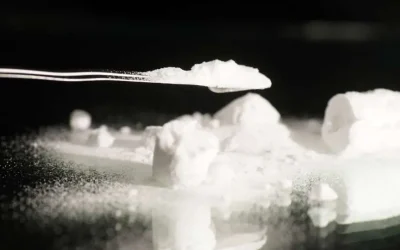Last updated: October, 2025
Crack cocaine, often called simply “crack,” is one of the most addictive substances known. Its power lies in how quickly it reaches the brain and how intensely it affects the body and mind. While the initial high feels euphoric and energizing, the crash that follows can be devastating, driving users to take another hit again and again.
Understanding how crack works and why it’s so addictive is key to recognizing the risks and knowing when to seek help. At Hacienda Paradiso, we provide safe, medical detox and evidence-based therapy to help people break the cycle of dependence and rebuild their lives.
What Is Crack Cocaine?
Crack is a form of cocaine that can be smoked. Regular cocaine, the white powder usually snorted, cannot be smoked safely. By dissolving cocaine hydrochloride in water and mixing it with a base like baking soda or ammonia, a solid crystal known as crack is created.
This “freebase” version vaporizes at lower temperatures, making it easy to smoke. The name “crack” comes from the crackling sound it makes when heated.
When smoked, crack enters the bloodstream through the lungs almost instantly. The result is a surge of dopamine (the brain’s pleasure chemical) that produces intense feelings of euphoria, energy, and confidence within seconds. However, the effects last only a few minutes, leading to a rapid and dangerous cycle of repeated use.
How Crack Affects the Brain and Body
Crack and cocaine act on the same parts of the brain, particularly those involved in reward and motivation. The difference is speed and intensity. Smoking crack delivers the drug to the brain faster, creating an immediate “rush” that’s far stronger than snorting powder cocaine.
Within seconds, users experience:
- Intense energy and alertness
- Heightened confidence and euphoria
- A strong sense of pleasure and power
But as quickly as the high arrives, it fades. The brain’s dopamine levels crash, leaving feelings of anxiety, restlessness, and irritability. This crash fuels an overwhelming urge to use again.
Physically, crack use increases heart rate, blood pressure, and body temperature. Breathing becomes shallow and rapid. Appetite disappears, sleep is disrupted, and over time the body becomes exhausted and malnourished.
The Cycle of Crack Addiction
The short-lived high and intense crash make crack one of the hardest drugs to quit. People often use repeatedly for hours or even days, moving from one hit to the next just to avoid the comedown.
This constant cycle quickly leads to tolerance, meaning higher doses are needed to feel the same effects. Dependence soon follows, both physical and psychological.
When someone stops using, the brain struggles to function without the drug. Depression, extreme fatigue, and strong cravings are common, making relapse highly likely without professional support.
Is Crack Physically and Mentally Addictive?
Yes, crack is both physically and psychologically addictive. Alongside heroin, methamphetamine, and nicotine, it ranks among the most habit-forming substances in the world.
The intense euphoria caused by the dopamine surge is deeply reinforcing, and the crash that follows is so uncomfortable that people feel compelled to use again. Over time, the brain becomes rewired to rely on crack for pleasure or relief from distress.
When use stops, withdrawal symptoms can include:
- Exhaustion and lack of energy
- Shaking, chills, and muscle pain
- Depression and irritability
- Strong cravings for crack
- Anxiety and restlessness
- Trouble sleeping and vivid nightmares
Because these symptoms are both physical and emotional, medical detox and psychological support are essential.
The Risks of Crack Use
Frequent or long-term crack use can cause severe harm to both the mind and body. Common risks include:
- Aggressive or paranoid behavior and extreme mood swings
- Damage to the heart and cardiovascular system, including stroke and heart attack
- Respiratory issues from inhaling toxic smoke
- Persistent anxiety, depression, or psychosis
- Severe weight loss and fatigue from poor appetite
- Relationship breakdowns and social isolation
- High risk of self-harm or reckless behavior due to impaired judgment
Because of its powerful psychological grip, many people find it nearly impossible to stop without professional help.

Crack Detox and Treatment at Hacienda Paradiso
Detoxing from crack cocaine is not only uncomfortable but potentially dangerous if attempted alone. The withdrawal phase can trigger strong depressive symptoms and suicidal thoughts.
At Hacienda Paradiso, detox is managed in a safe, medically supervised environment. Our experienced doctors and nurses monitor your condition around the clock to ensure safety and comfort during the process.
Medical detox focuses on stabilizing the body while also preparing the mind for recovery. Psychological support begins early in the process, helping to address the emotional roots of addiction and reduce the risk of relapse.
Once detox is complete, therapy continues with a tailored treatment plan that may include:
- Cognitive Behavioural Therapy (CBT) to identify negative thinking patterns
- Trauma-informed therapy for those using crack as a coping mechanism
- Group therapy to rebuild social connections and accountability
- Holistic treatments, including mindfulness, yoga, and fitness, to restore balance
- Aftercare planning, ensuring long-term support after leaving the program
Recovery at Hacienda Paradiso is about much more than stopping crack use. It’s about rebuilding self-esteem, repairing relationships, and rediscovering a sense of purpose.
How to Begin Recovery
If you or someone you care about is caught in the cycle of crack addiction, help is available. The first step is to reach out for professional guidance: you don’t have to face withdrawal or recovery alone.
At Hacienda Paradiso, we combine expert medical care with compassionate, individualized treatment in a peaceful, natural setting. With the right support, long-term recovery is not only possible, it’s within reach.
FAQ — Crack Addiction and Recovery
Extremely addictive. The high is fast and powerful, while the crash is immediate and painful, driving repeated use. Dependence can develop within days.
Only a few minutes, making users crave another hit almost immediately, which increases the risk of addiction.
Fatigue, depression, anxiety, intense cravings, sleep disturbances, and body aches. These symptoms require medical supervision for safety and comfort.
Both are harmful, but crack acts faster and with greater intensity, making it more addictive and damaging in the long term.
Through medically supervised detox, personalized therapy, and holistic support focused on long-term recovery in a calm, natural environment.









